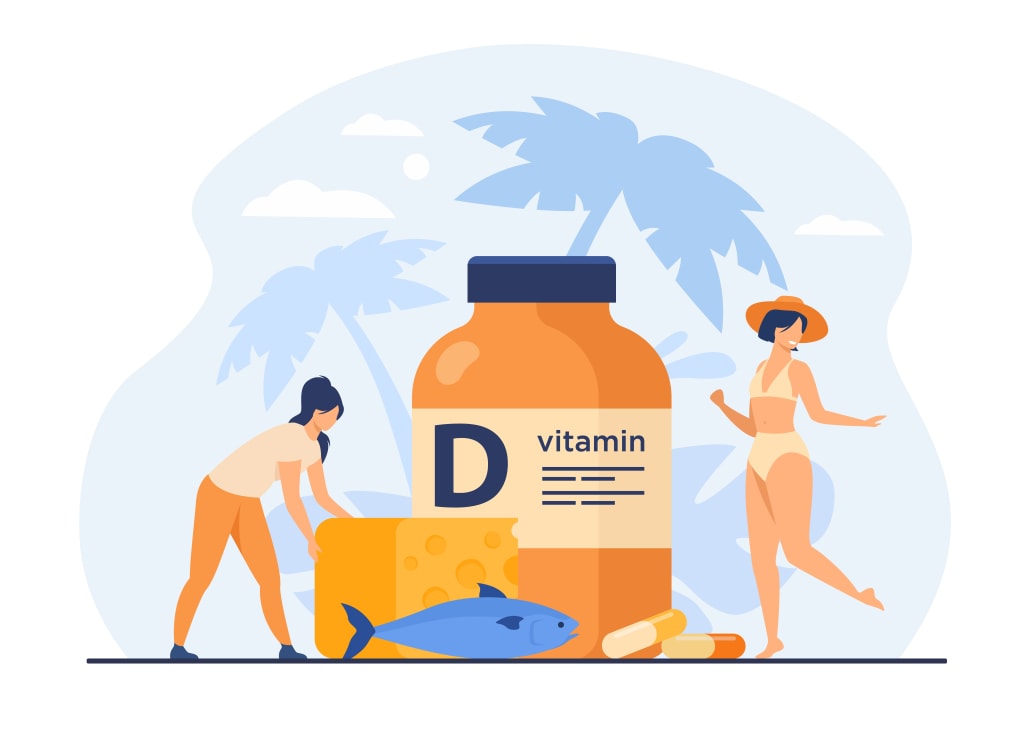Are You Getting Enough Vitamin D? Signs You Might Be Deficient, Risk Factors and Best Sources of Vitamin D
Unlocking the Mystery of Vitamin D: Identifying Deficiency Signs, Understanding Risk Factors, and Discovering Top Sources for Adequate Intake

Introduction
Vitamin D is an essential nutrient that is necessary for maintaining overall health and wellness. It plays a critical role in the body by regulating calcium and phosphate levels, which are important for bone and muscle health. Vitamin D deficiency is a common problem, particularly in areas with limited sunlight exposure, and can have serious health consequences. The signs and symptoms of vitamin D deficiency can be subtle and may include fatigue, weakness, bone pain and an increased risk of fractures. In this article, we will provide an overview of the signs and symptoms of vitamin D deficiency, as well as an explanation of the different risk factors that can contribute to deficiency. It will also offer actionable advice for getting more vitamin D in the diet and lifestyle, including recommendations for sunlight exposure, vitamin D-rich foods, and supplementation. Overall, this blog post is designed to educate and empower readers to take control of their health by ensuring they are getting enough vitamin D.
What is Vitamin D and Why Is It Important?
Vitamin D is a fat-soluble vitamin that is essential for the maintenance of good health. It is unique in that it can be synthesized by the body in response to sunlight exposure as well as obtained through dietary sources. Vitamin D plays a crucial role in maintaining healthy bones and teeth by regulating calcium and phosphate levels in the body. It also has a wide range of other important functions, including immune system regulation, muscle function, and cell growth and differentiation.

Different types of vitamin D and how they are absorbed and used by the body
There are two main types of vitamin D: vitamin D2 (ergocalciferol) and vitamin D3 (cholecalciferol). Vitamin D2 is primarily found in plant-based sources, such as mushrooms and fortified foods, while vitamin D3 is produced by the skin in response to sunlight and can also be found in animal-based sources, such as fatty fish and egg yolks. Once absorbed by the body, vitamin D is converted into its active form, calcitriol, which can bind to receptors throughout the body to carry out its many functions.
Role of vitamin D in the body
Vitamin D is an essential nutrient with a wide range of important functions in the body. Its role in maintaining healthy bones and teeth is well-known, but it also plays a crucial role in regulating immune function, muscle function, and cell growth and differentiation. By understanding the different types of vitamin D and how they are absorbed and used by the body, we can take steps to ensure we are getting enough of this vital nutrient to support our overall health.
Signs and Symptoms of Vitamin D Deficiency
Vitamin D deficiency can cause a variety of symptoms, which can range from mild to severe. Let’s discuss all points one by one.
Overview of the most common signs and symptoms of vitamin D deficiency
Vitamin D deficiency is a common problem, and its signs and symptoms can be subtle and easily overlooked. The most common signs of vitamin D deficiency include fatigue, weakness, and muscle pain, which can often be mistaken for other health issues. However, over time, vitamin D deficiency can lead to more serious health problems, such as weakened bones, increased risk of fractures, and osteoporosis.
Relationship between vitamin D deficiency and bone health
In addition to its role in bone health, vitamin D deficiency can also impact overall health and wellness. Research has shown that low levels of vitamin D are associated with a weakened immune system, making individuals more susceptible to infections and illness. Moreover, vitamin D deficiency has been linked to mental health disorders, including depression and anxiety. This highlights the importance of ensuring that we are getting enough vitamin D to support our physical and mental health.
How vitamin D deficiency can impact overall health and wellness?
It is important to note that while certain groups, such as older adults, pregnant women, and individuals with limited sun exposure, may be more at risk for vitamin D deficiency, anyone can develop this condition. By being aware of the signs and symptoms of vitamin D deficiency and taking proactive steps to address it, such as getting more sunlight exposure, eating vitamin D-rich foods, or taking vitamin D supplements, we can help to maintain optimal vitamin D levels and support our overall health and wellbeing.
Risk Factors for Vitamin D Deficiency
Vitamin D deficiency is a common issue, and there are several risk factors that can contribute to this condition. One of the most significant risk factors is inadequate sun exposure, as vitamin D is primarily produced in the skin when it is exposed to sunlight. Individuals who spend most of their time indoors or who live in areas with limited sunlight may be at increased risk for vitamin D deficiency.
Dietary factors
Dietary factors can also play a role in vitamin D deficiency, as few foods naturally contain vitamin D. Therefore, individuals who follow a strict vegan or vegetarian diet, or who have limited access to vitamin D-rich foods such as fatty fish or fortified dairy products, may also be at risk.
Age Factor
Age is another factor that can contribute to vitamin D deficiency, as the skin's ability to produce vitamin D decreases with age. Additionally, older adults may be more likely to spend less time outdoors and have less efficient kidneys, which can reduce the body's ability to convert vitamin D to its active form.
Medical Conditions
Medical conditions can also increase the risk of vitamin D deficiency, including Crohn's disease, celiac disease, and obesity. These conditions can impact the body's ability to absorb and use vitamin D properly, which can lead to deficiencies.
It is important to identify and address these risk factors to prevent vitamin D deficiency. This may involve increasing sun exposure, adding vitamin D-rich foods to the diet, or taking supplements as recommended by a healthcare provider. By taking proactive steps to address these risk factors, individuals can maintain optimal vitamin D levels and support overall health.
Best sources of vitamin D
Getting enough vitamin D is important for overall health. There are several ways to obtain vitamin D, including sunlight, food, and supplements. Sunlight is the most natural way to get vitamin D, as it triggers vitamin D production in the skin. However, it is essential to practice safe sun exposure and avoid overexposure to prevent skin damage and other health risks.

Dietary sources of vitamin D include fatty fish, such as salmon and tuna, as well as fortified foods like milk, cereal, and orange juice. It can be challenging to obtain adequate vitamin D from food alone, so supplements may be necessary, especially for individuals at high risk of deficiency.
The recommended daily intake of vitamin D varies based on factors such as age, sex, and medical conditions. For example, the National Institutes of Health recommends a daily intake of 600-800 IU (International Units) of vitamin D for most adults. However, individuals with certain medical conditions or at high risk for deficiency may require higher doses under the guidance of a healthcare provider.
Incorporating vitamin D-rich foods and safe sun exposure practices into a healthy lifestyle and dietary pattern can help individuals meet their vitamin D needs and support overall health and wellness. It is essential to consult with a healthcare provider to determine the best approach to obtaining adequate vitamin D based on individual needs and risk factors.
Conclusion
In conclusion, vitamin D is an essential nutrient for overall health, playing a crucial role in bone health, immune function, and other physiological processes. Vitamin D deficiency is common, and the signs and symptoms can impact overall health and wellness. Identifying and addressing risk factors, such as inadequate sun exposure, diet, age, and certain medical conditions is essential to prevent vitamin D deficiency.
To ensure adequate vitamin D intake, individuals can incorporate safe sun exposure practices, vitamin D-rich foods, and supplements into their lifestyle and dietary pattern. It is important to consult with a healthcare provider to determine the best approach based on individual needs and risk factors.
About the Creator
Ubuy Saudi
Ubuy paved its way in the e-commerce world in the year 2012 as a cross-border shopping platform. This product-based company provides services to customers in around 180+ countries.
Shop premium products from international brands






Comments
There are no comments for this story
Be the first to respond and start the conversation.